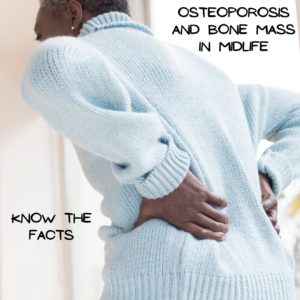
Do you have a family member over 50 who has suffered a fracture due to a fall from a standing height? Chances are you may have Osteoporosis. In fact, approximately 10 million Americans have Osteoporosis and 44 million also have low bone mass. Bone disease is silent but may, in some situations, be debilitating. That is why it is important for those in midlife and beyond to understand the hereditary components, the risks associated with it and how to maintain strong bone mass.
Bone is a living tissue that we create, we lose and then regenerate again. The National Osteoporosis Foundation (NOF) defines Osteoporosis as “a bone disease that occurs when the body loses too much bone, makes too little bone, or both. As a result, bones become weak and may break from a fall or, in serious cases, from sneezing or minor bumps.” What many people don’t realized is that it is actually a pediatric condition that manifests itself as we age. Individuals develop our strongest bone mass by age 25 and will not gain additional density from that baseline. We then spend the rest of our lives trying to regenerate more bone than we lose.
How do we create peak bone mass? According to Claire Gill, CEO of NOF, there are several things we could be doing.
- We can make sure to have enough calcium and Vitamin D in our diet. While she recommends that most of the daily vitamins should be received through our food (dairy products, dark green leafy vegetables, canned salmon or sardines and soy products), we can supplement in accordance with the recommended daily intake levels. For example, women under 50 should have a daily intake of 1000 mg of calcium. If you get 500 from food, you will only need to take a 500mg supplement.
- We can limiting alcohol and not smoke.
- Weight bearing exercises should be added to build bone. These exercises include walking, running, dancing and hiking. Claire stresses that while swimming and cycling are good for cardio, they do not help with bone loss.
- Strength training will help protect the bone.
- We should also add balancing exercises like Pilates and Yoga to help us from falling.
What is the relationship between bone loss and Menopause? According to Endocrine.org, “Menopause is the most common cause of osteoporosis. As hormones change to accommodate normal menopausal changes, estrogen level start to fluctuate and then drop. Since estrogen helps prevent bones from getting weaker by slowing the natural breakdown of bone, its reduction during menopause significantly speeds up bone loss.” It goes on to state that Menopause can cause up to 20% of bone loss and that 1 in 2 postmenopausal women will have Osteoporosis.
How can we find out if we have Osteoporosis? The reality of insurance is that bone density tests are not covered by Medicare until age 65. However, Claire states that if you are over 50 and fall from a standing height and break a bone, you need a bone density test (i.e. the Dexa scan). A DEXA scan is an imaging test that is non invasive and will measure your bone density/strength. The numerical range you are given will indicate if you are in Osteopenia or have Osteoporosis.
Once you are diagnosed, what can you to slow the progression of bone loss? Most people will start with diet and exercise. As referenced above, the importance of Calcium and Vitamin D along with weight bearing exercise can slow the progression. If diet and exercise are not enough, there are several treatment options available. Check with your doctors about:
- Fosamax
- Prolia
- Actonel
- Reclast
- Boniva
These are just a few of the options. Every patient is different and you need to discuss with your doctor about what is right for you.
You should also be aware that there are conditions that can affect bone loss and also treatments that may exacerbate it. Conditions including Celiac disease, IBS, MS treatment or Diabetes and the use of steroids (which strips calcium) or chemotherapy drugs are just a few examples.
We have peak bone mass by age 25 and we spend the rest of our lives trying to maintain healthy bone. While diet and exercise can help, it is important to remember that Osteoporosis is 90% hereditary. If you have had a family member over 50 fracture a bone from a standing height, you should ask you doctor about a bone density scan. You can also check the NOF.org website for more information and you can contact them directly at [email protected] with additional questions.